The foundation of any thriving relationship rests on open communication, understanding, and mutual respect. However, maintaining these qualities consistently can be a daunting task, especially when life’s inevitable challenges arise. That’s where Cognitive Behavioral Therapy comes in. Designed to foster a deep sense of understanding between partners, CBT techniques can revolutionize the way you perceive, interpret, and interact within your relationship. In this blog, we’ll delve into the heart of CBT couples therapy and how it can bring about transformative change in your relationship dynamics.
Contents
Is CBT Good For Couples Therapy?
 Absolutely, Cognitive Behavioral Therapy (CBT) can be an effective approach in couples therapy. CBT is an evidence-based psychological treatment proven to help with various issues, including relationship problems. It’s built on the understanding that our perceptions shape our responses. And in the context of a relationship, misperceptions about each other’s behavior can lead to conflicts and dissatisfaction.
Absolutely, Cognitive Behavioral Therapy (CBT) can be an effective approach in couples therapy. CBT is an evidence-based psychological treatment proven to help with various issues, including relationship problems. It’s built on the understanding that our perceptions shape our responses. And in the context of a relationship, misperceptions about each other’s behavior can lead to conflicts and dissatisfaction.
Moreover, CBT can bring about meaningful change within a relationship by enhancing emotional understanding and empathy, promoting behavioral adjustments. Ultimately, improving overall relationship satisfaction. It equips couples with tools and techniques to solve their problems in a more productive way, enhancing the bond between them. However, the effectiveness of CBT, like any therapy, hinges on the willingness of both partners to participate in the process.
How Does CBT Couples Therapy Work?
Cognitive Behavioral Therapy (CBT) for couples operates on the premise that thoughts, feelings, and behaviors are interconnected and can influence one another. Here’s a basic breakdown of how CBT couples therapy generally works:
- Problem Identification: The first step involves identifying the issues that the couple is facing. This could include communication problems, emotional disconnect, trust issues, recurring conflicts, or any other relational difficulties. Both partners are encouraged to openly express their feelings and perspectives.
- Exploration of Thoughts and Beliefs: Once the issues have been identified, the therapist will help the couple explore their thoughts, beliefs, and assumptions about these issues. This can often reveal cognitive distortions or unhelpful thinking patterns that contribute to relationship problems.
- Understanding Emotional Responses and Behaviors: The next step involves examining how these thoughts and beliefs trigger emotional responses and influence behaviors. For instance, if one partner has a fear of abandonment, they may become overly clingy, which can create tension in the relationship.
- Developing and Implementing Strategies: After understanding the link between thoughts, emotions, and behaviors, the therapist guides the couple to develop strategies for changing harmful thought patterns and behaviors. These might include communication exercises, problem-solving techniques, or mindfulness practices.
- Review and Practice: The couple is then encouraged to apply these strategies in their daily lives. Progress is reviewed in subsequent therapy sessions, and the strategies are adjusted as needed.
- Maintenance: Once the couple has made significant progress, they move onto the maintenance stage. This stage focuses on reinforcing the new patterns of thinking and behavior and developing plans to manage any future relationship difficulties.
What Techniques Are Used In CBT Couples Therapy?
 CBT couple therapy involves various techniques designed to help couples identify and change unhelpful thoughts and behaviors. Here are some of the most commonly used techniques:
CBT couple therapy involves various techniques designed to help couples identify and change unhelpful thoughts and behaviors. Here are some of the most commonly used techniques:
Thought Records
This technique involves keeping a diary of thoughts, feelings, and behaviors to identify patterns and triggers. It helps individuals understand how certain situations or interactions lead to negative thoughts and emotional reactions.
Cognitive Restructuring
This technique is about challenging and changing negative thought patterns. The therapist helps the couple to identify distorted thoughts. And replace them with more realistic and positive ones.
Behavioral Activation
This is a technique used to increase engagement in positive and rewarding activities. For couples, it could involve scheduling enjoyable activities together to improve their connection and positive interactions.
Communication Skills Training
Good communication is fundamental to a healthy relationship. In CBT couples therapy, partners learn how to express their thoughts and feelings effectively and how to listen to and understand each other better.
Problem-Solving Therapy
This technique helps couples develop effective strategies for dealing with conflicts and issues. It typically involves defining the problem, brainstorming solutions, deciding on the best one, implementing it, and reviewing its effectiveness.
Relaxation Techniques
Stress can often exacerbate relationship problems. Techniques like deep breathing, progressive muscle relaxation, and guided imagery can help individuals manage stress and approach relationship challenges more calmly.
Exposure Therapy
If a couple is dealing with specific fears or phobias that affect their relationship, exposure therapy might be used. This involves gradually and safely exposing individuals to the situations they fear to help them manage their anxiety.
Remember, the techniques used in CBT couples therapy can vary depending on the specific issues the couple is facing and the therapist’s approach. It’s also important to note that the success of these techniques relies heavily on the couple’s commitment to the process and their willingness to apply what they’ve learned in their daily life.



